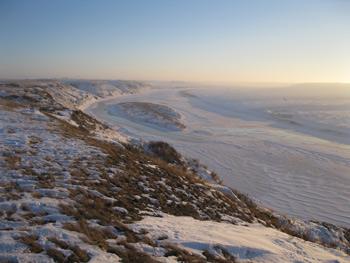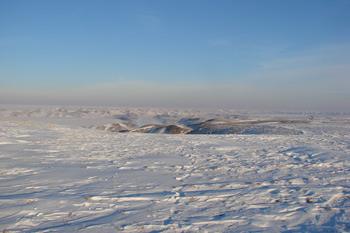Coyote Hunting Wind Myths
By Ted Haynes
During the many years that I have hunted coyotes, the most common saying I have heard is, "When the wind blows, stay home." In Southern Alberta, if you were to honor that mantra you would never leave the house. The wind blows on most days, and generally just keeps coming and coming out of the west.

Coyote hunting articles always state to have the wind in your face, or at least have a crosswind. Yes, I would prefer that for sure, but it is not always the case. At times you cannot reach your selected stand location from the right direction due to snow or a locked gate, which means to either have the wind at your back or go home.
When the wind is at my back, what has worked for me is to sneak over the crest of the hill and set up about ten yards or more from the top. Now the wind is blowing over me and out, not directly down. Perhaps the coyote will not get my scent, but the coyote may still sniff me out. So I make up my mind to get ready to take the long shot. In these types of circumstances, I know I am going to have to shoot the coyote at between 200 to 300 yards, or just sit there and watch his tail moving away after he catches my scent. Then again, for some strange reason, a coyote will sometimes simple disregard the human scent and keep coming in and then die at less then 100 yards.
On one occasion I was out coyote hunting although I should have stayed home, but being too stubborn, I went to an area where coyotes always hang out. This area is at the end of the lake and has a very large section of bulrushes. The wind was blowing out of the northwest at 45 miles an hour minimum. I got to the stand location, just under the crest of the hill, with the wind at my back blowing out and towards the bulrushes. I had set up north and west of the bulrushes. If I had ever made a single mistake with the wind, I was making them all now. The only thing I really had going for me was my ability to get to the location without being detected.
The wind was howling. I got ready to call. First I used a rabbit squeal. The wind sucked that call right out of my lips. Then I let a couple of coyote howls rip and waited. Nothing. Another series of howls, and there it was on the ice, a coyote coming at an angle towards me. I did a couple of pup squeals when the coyote slowed. The coyote was now on the move again. I had already used my rangefinder and knew a certain rock on the ice was at 325 yards. When the coyote got to that rock, I knew it was at the death spot.

Compensating for the wind, I held 8 inches high and 12 inches in front of the coyote's nose. The gun went off. Due to the wind, it was not your usual loud bang, but a light puff. I was in shock. There was a coyote spinning on the ice. Then the coyote broke through the thin ice and was in the water. I had missed. I could see a coyote running south back to the bulrushes. I looked back at the coyote on the ice, and it was indeed the one I had shot. It had been heart shot and was now motionless. Two coyotes had been coming to the call and I had been concentrating so hard on the first one that I had never noticed the second coyote. Now I will never doubt the ears of a coyote.
In looking at this again, should I have gone to the other side of the lake and called with the wind in my face? I doubt I would have lasted there for more than a couple minutes due to the cold and strength of the wind. Still, would the coyotes have been able to discern the call of the howler? The wind does distort the call and sucks it right out of your lips.
This situation, and many others like it, make me think back to my motto: If you have not seen it happen yet, you need to hunt more.
Ted Haynes
TJ Coyote.
For the past twenty five years Ted Haynes has been employed as a peace officer with the Royal Canadian Mounted Police. And for the last 10 years he has lived and hunted in Southern Alberta, where he has gotten hooked on calling coyotes. Between September 7, 2002 and March 3, 2003, he decided to see how many days in a row he could either go hunting or go to the range. During this nearly six month period he honed his skills as a coyote caller.
By Ted Haynes
During the many years that I have hunted coyotes, the most common saying I have heard is, "When the wind blows, stay home." In Southern Alberta, if you were to honor that mantra you would never leave the house. The wind blows on most days, and generally just keeps coming and coming out of the west.

Coyote hunting articles always state to have the wind in your face, or at least have a crosswind. Yes, I would prefer that for sure, but it is not always the case. At times you cannot reach your selected stand location from the right direction due to snow or a locked gate, which means to either have the wind at your back or go home.
When the wind is at my back, what has worked for me is to sneak over the crest of the hill and set up about ten yards or more from the top. Now the wind is blowing over me and out, not directly down. Perhaps the coyote will not get my scent, but the coyote may still sniff me out. So I make up my mind to get ready to take the long shot. In these types of circumstances, I know I am going to have to shoot the coyote at between 200 to 300 yards, or just sit there and watch his tail moving away after he catches my scent. Then again, for some strange reason, a coyote will sometimes simple disregard the human scent and keep coming in and then die at less then 100 yards.
On one occasion I was out coyote hunting although I should have stayed home, but being too stubborn, I went to an area where coyotes always hang out. This area is at the end of the lake and has a very large section of bulrushes. The wind was blowing out of the northwest at 45 miles an hour minimum. I got to the stand location, just under the crest of the hill, with the wind at my back blowing out and towards the bulrushes. I had set up north and west of the bulrushes. If I had ever made a single mistake with the wind, I was making them all now. The only thing I really had going for me was my ability to get to the location without being detected.
The wind was howling. I got ready to call. First I used a rabbit squeal. The wind sucked that call right out of my lips. Then I let a couple of coyote howls rip and waited. Nothing. Another series of howls, and there it was on the ice, a coyote coming at an angle towards me. I did a couple of pup squeals when the coyote slowed. The coyote was now on the move again. I had already used my rangefinder and knew a certain rock on the ice was at 325 yards. When the coyote got to that rock, I knew it was at the death spot.

Compensating for the wind, I held 8 inches high and 12 inches in front of the coyote's nose. The gun went off. Due to the wind, it was not your usual loud bang, but a light puff. I was in shock. There was a coyote spinning on the ice. Then the coyote broke through the thin ice and was in the water. I had missed. I could see a coyote running south back to the bulrushes. I looked back at the coyote on the ice, and it was indeed the one I had shot. It had been heart shot and was now motionless. Two coyotes had been coming to the call and I had been concentrating so hard on the first one that I had never noticed the second coyote. Now I will never doubt the ears of a coyote.
In looking at this again, should I have gone to the other side of the lake and called with the wind in my face? I doubt I would have lasted there for more than a couple minutes due to the cold and strength of the wind. Still, would the coyotes have been able to discern the call of the howler? The wind does distort the call and sucks it right out of your lips.
This situation, and many others like it, make me think back to my motto: If you have not seen it happen yet, you need to hunt more.
Ted Haynes
TJ Coyote.
For the past twenty five years Ted Haynes has been employed as a peace officer with the Royal Canadian Mounted Police. And for the last 10 years he has lived and hunted in Southern Alberta, where he has gotten hooked on calling coyotes. Between September 7, 2002 and March 3, 2003, he decided to see how many days in a row he could either go hunting or go to the range. During this nearly six month period he honed his skills as a coyote caller.

